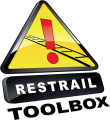20.1 Posters
This measure consists of provision of posters at stations and outside stations at locations where trespassing is frequent to deliver information about dangers related to trespassing. The aim is to increase the awareness of all railway trespassers about the dangers related to crossing the railway lines at illegal places.
- Posters are aimed only to deliver information about dangers related to trespassing. They should be informative and do not try to prohibit / dictate behaviour.
- Each poster message needs to address a special target group and should be tested on a panel before launching. It is necessary to have this right so the message is clearly addressed.
- Periodically check the condition of the posters and, if needed, make necessary actions to update their condition.
- Suitably trained staff will be needed to design effective posters both in terms of content and appearance.
- Extend the poster campaign to other locations beyond rail locations where children have time to stop, read and digest the messages conveyed (for e.g. within the school and other youth environments in the run up to major holidays).
- Consider the priority locations and install in visible places. Have in mind the visual span and eyesight of the people you are targeting.
- Make sure that there are no more posters than absolutely necessary, otherwise people may overlook them.
- The effect of posters is highly depended on the amount of installed posters.
- The effect of posters is likely to be reduced over time. The effect can be maintained by replacing the old and grungy posters by new ones. The effect can be increased also by changing the content / design of the posters from time to time (e.g. a new poster every year or twice a year). For example, the poster campaigns in Great Britain are re-launched after 2½ years with new poster designs.
- The design of the signs/posters should be carefully planned. It might be that the same design is not effective in all cultures. For example some railway undertakings could disagree with the message shown as they might not like the depiction of a (recognizable, their company) train on a poster.
- It is important that the posters use a language that everyone can understand (i.e. removing old posters and replacing them with posters in a ‘modern’ language).
- Be careful with the message “trespassing is dangerous” this could attract possible suicidal persons to the tracks. It is better to address to “the delays caused by trespassers” and “the number of people that are inconvenienced by those delays”.
- Best to be combined with targeted campaigns.
- Combine them with prohibitive signs. Placing signs with about the same message next to each other (e.g. one is an icon, the other a picture with text, the other is a prohibitive sign).
- Need support from station owners/operators etc. for space to place posters and may compete with others for space (e.g. displacing advertising revenue).
- Station signage can be an effective way of reducing trespass (RSSB , 2005).
- After a study based on focus group involving children about the effectiveness of « do not trespass » signs (RSSB , 2006), it was concluded that there is a need to provide information about why trespassing is not allowed instead of only indicate that trespass is prohibited. In addition it was found that redesigned anti-trespass signs based on children’s suggestions were no more effective than existing ones. The study was however very qualitative, with no actual measure of its safety performance. This study also showed that children have a very weak knowledge about rail-related risks.
- Fencing combined with warning signs, posters and education at school: the rate of trespass decreased substantially (from 59% to 40%) and the decrease was sustained and even greater three months later (from 40% to 36%) (Lobb et al., 2001).
- Posters were tested by CIDAUT in Valladolid Universidad station (Spain) in combination with other measures and as part of RESTRAIL pilot tests conducted in 2014.
last update: 2015-01-19 Print

